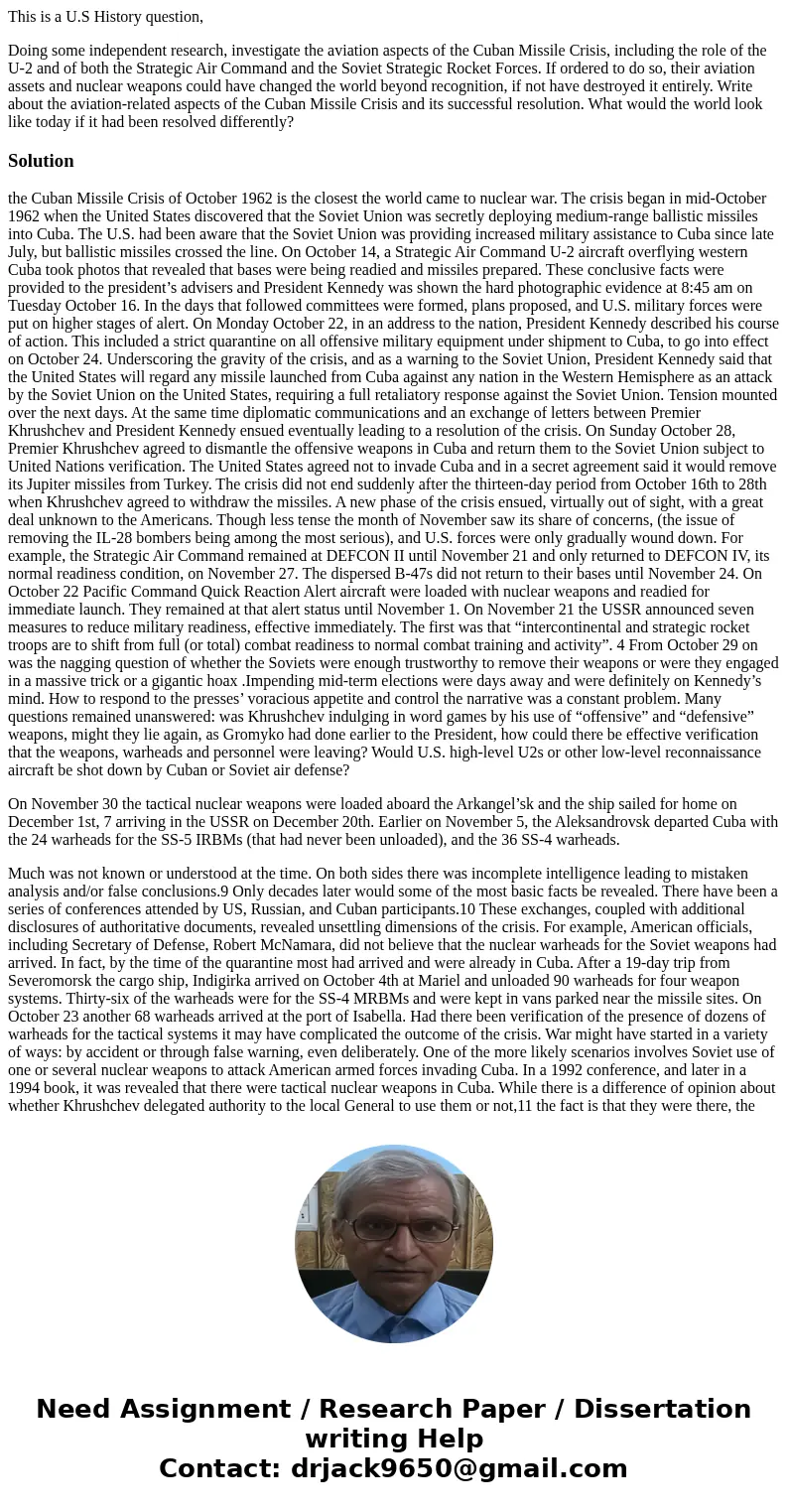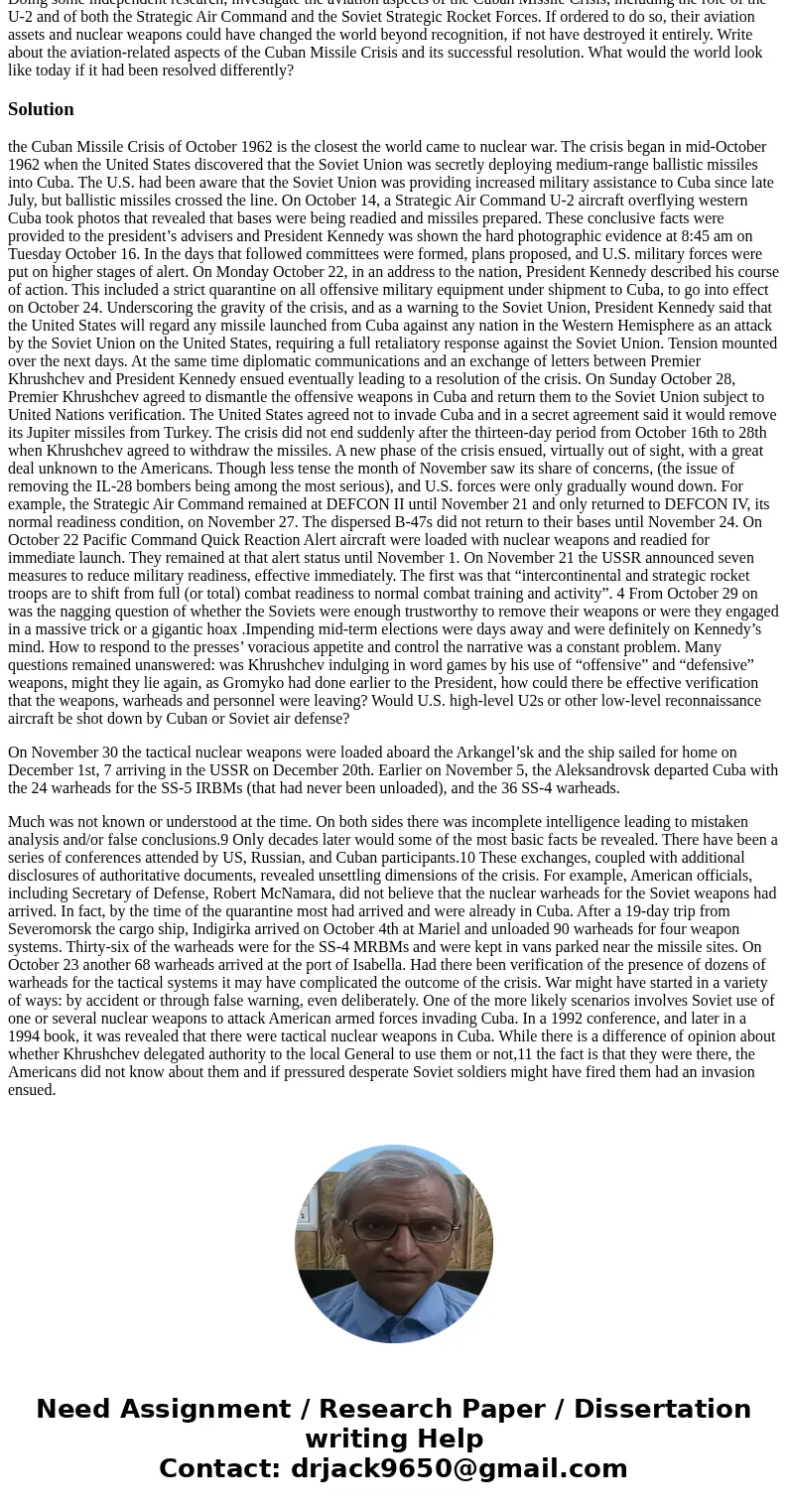This is a US History question Doing some independent researc
This is a U.S History question,
Doing some independent research, investigate the aviation aspects of the Cuban Missile Crisis, including the role of the U-2 and of both the Strategic Air Command and the Soviet Strategic Rocket Forces. If ordered to do so, their aviation assets and nuclear weapons could have changed the world beyond recognition, if not have destroyed it entirely. Write about the aviation-related aspects of the Cuban Missile Crisis and its successful resolution. What would the world look like today if it had been resolved differently?
Solution
the Cuban Missile Crisis of October 1962 is the closest the world came to nuclear war. The crisis began in mid-October 1962 when the United States discovered that the Soviet Union was secretly deploying medium-range ballistic missiles into Cuba. The U.S. had been aware that the Soviet Union was providing increased military assistance to Cuba since late July, but ballistic missiles crossed the line. On October 14, a Strategic Air Command U-2 aircraft overflying western Cuba took photos that revealed that bases were being readied and missiles prepared. These conclusive facts were provided to the president’s advisers and President Kennedy was shown the hard photographic evidence at 8:45 am on Tuesday October 16. In the days that followed committees were formed, plans proposed, and U.S. military forces were put on higher stages of alert. On Monday October 22, in an address to the nation, President Kennedy described his course of action. This included a strict quarantine on all offensive military equipment under shipment to Cuba, to go into effect on October 24. Underscoring the gravity of the crisis, and as a warning to the Soviet Union, President Kennedy said that the United States will regard any missile launched from Cuba against any nation in the Western Hemisphere as an attack by the Soviet Union on the United States, requiring a full retaliatory response against the Soviet Union. Tension mounted over the next days. At the same time diplomatic communications and an exchange of letters between Premier Khrushchev and President Kennedy ensued eventually leading to a resolution of the crisis. On Sunday October 28, Premier Khrushchev agreed to dismantle the offensive weapons in Cuba and return them to the Soviet Union subject to United Nations verification. The United States agreed not to invade Cuba and in a secret agreement said it would remove its Jupiter missiles from Turkey. The crisis did not end suddenly after the thirteen-day period from October 16th to 28th when Khrushchev agreed to withdraw the missiles. A new phase of the crisis ensued, virtually out of sight, with a great deal unknown to the Americans. Though less tense the month of November saw its share of concerns, (the issue of removing the IL-28 bombers being among the most serious), and U.S. forces were only gradually wound down. For example, the Strategic Air Command remained at DEFCON II until November 21 and only returned to DEFCON IV, its normal readiness condition, on November 27. The dispersed B-47s did not return to their bases until November 24. On October 22 Pacific Command Quick Reaction Alert aircraft were loaded with nuclear weapons and readied for immediate launch. They remained at that alert status until November 1. On November 21 the USSR announced seven measures to reduce military readiness, effective immediately. The first was that “intercontinental and strategic rocket troops are to shift from full (or total) combat readiness to normal combat training and activity”. 4 From October 29 on was the nagging question of whether the Soviets were enough trustworthy to remove their weapons or were they engaged in a massive trick or a gigantic hoax .Impending mid-term elections were days away and were definitely on Kennedy’s mind. How to respond to the presses’ voracious appetite and control the narrative was a constant problem. Many questions remained unanswered: was Khrushchev indulging in word games by his use of “offensive” and “defensive” weapons, might they lie again, as Gromyko had done earlier to the President, how could there be effective verification that the weapons, warheads and personnel were leaving? Would U.S. high-level U2s or other low-level reconnaissance aircraft be shot down by Cuban or Soviet air defense?
On November 30 the tactical nuclear weapons were loaded aboard the Arkangel’sk and the ship sailed for home on December 1st, 7 arriving in the USSR on December 20th. Earlier on November 5, the Aleksandrovsk departed Cuba with the 24 warheads for the SS-5 IRBMs (that had never been unloaded), and the 36 SS-4 warheads.
Much was not known or understood at the time. On both sides there was incomplete intelligence leading to mistaken analysis and/or false conclusions.9 Only decades later would some of the most basic facts be revealed. There have been a series of conferences attended by US, Russian, and Cuban participants.10 These exchanges, coupled with additional disclosures of authoritative documents, revealed unsettling dimensions of the crisis. For example, American officials, including Secretary of Defense, Robert McNamara, did not believe that the nuclear warheads for the Soviet weapons had arrived. In fact, by the time of the quarantine most had arrived and were already in Cuba. After a 19-day trip from Severomorsk the cargo ship, Indigirka arrived on October 4th at Mariel and unloaded 90 warheads for four weapon systems. Thirty-six of the warheads were for the SS-4 MRBMs and were kept in vans parked near the missile sites. On October 23 another 68 warheads arrived at the port of Isabella. Had there been verification of the presence of dozens of warheads for the tactical systems it may have complicated the outcome of the crisis. War might have started in a variety of ways: by accident or through false warning, even deliberately. One of the more likely scenarios involves Soviet use of one or several nuclear weapons to attack American armed forces invading Cuba. In a 1992 conference, and later in a 1994 book, it was revealed that there were tactical nuclear weapons in Cuba. While there is a difference of opinion about whether Khrushchev delegated authority to the local General to use them or not,11 the fact is that they were there, the Americans did not know about them and if pressured desperate Soviet soldiers might have fired them had an invasion ensued.


 Homework Sourse
Homework Sourse